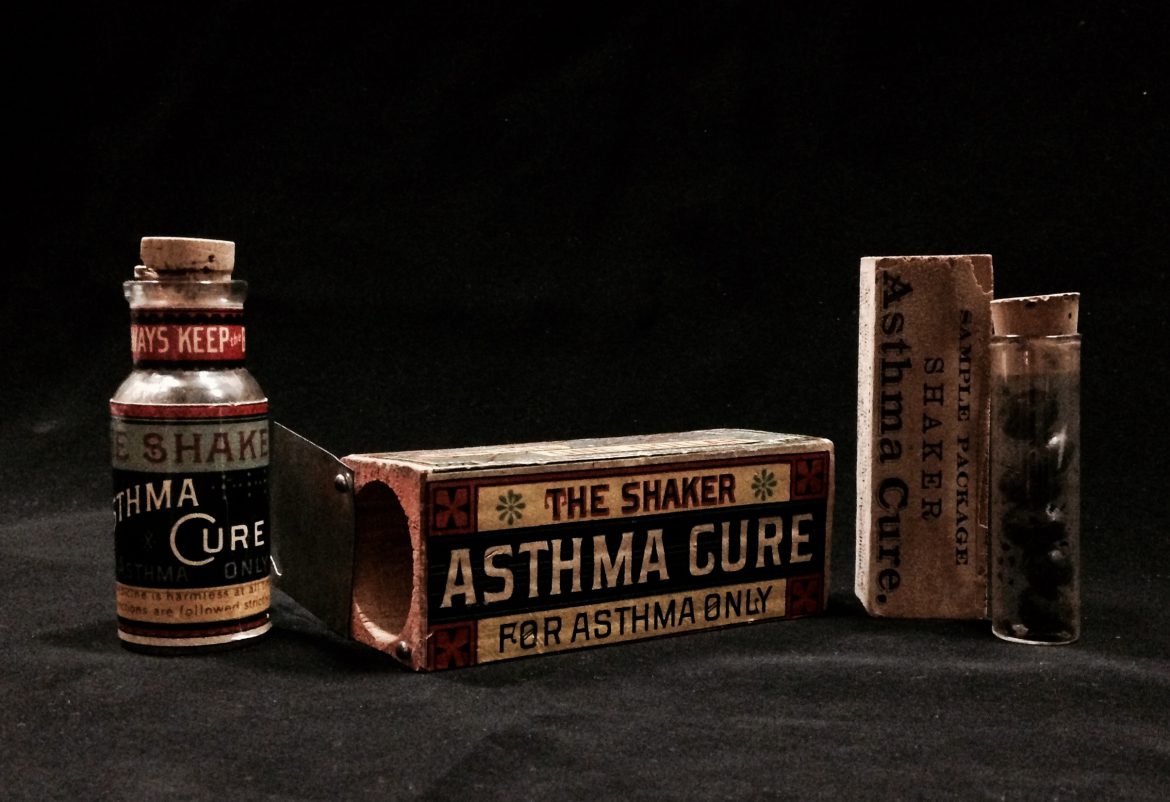
Shaker Asthma Cure Bottle and Shipping Box with Sample Package of the Same, Second Family, Mount Lebanon, NY, ca. 1880s-1890s, Shaker Museum } Mount Lebanon: 1957.9330.1 (Shipping Container); 1957.9330.3 (Sales Bottle with Pills); 1999.1.161a (Sample Shipping Box); 1999.1.161b (Sample Bottle with Pills).
Mount Lebanon’s Second Family was at one time probably the community’s largest family, comprised of not only the home farm – those buildings and properties now referred to as the Second Family – but also the South Farm, the West Farm, and the East Family. In the years prior to the Civil War, the Mount Lebanon Second Family presented a seemingly […]
Mount Lebanon’s Second Family was at one time probably the community’s largest family, comprised of not only the home farm – those buildings and properties now referred to as the Second Family – but also the South Farm, the West Farm, and the East Family. In the years prior to the Civil War, the Mount Lebanon Second Family presented a seemingly strong financial outlook. They had an adequate farming program to support the family and, as the chair business at the South Farm was under their jurisdiction, a successful industrial one as well. During the late-1850s and early 1860s the South Farm became the South Family and as it assumed control of its own finances, the Second Family appears to have suffered from losing its industrial component. The West Farm failed to thrive and its residents were assimilated into other families and in 1872 the East Family’s Elder and financial manager, Edward Chase, absconded, leaving the Shakers as much as $25,000 dollars (more than half a million in today’s dollars) in unexpected debt to people in the outside world. The East Family was broken up by 1875. To add further stress, by the early 1880s the Second Family seed business was not keeping up with competition from seed merchants in the outside world. In consideration of all of these changes, the Lebanon Ministry tried to identify businesses that would help the Family regain its financial footing.

Shaker Asthma Cure Bottle and Shipping Box with Sample Package of the Same, Second Family, Mount Lebanon, NY, ca. 1880s-1890s, Shaker Museum } Mount Lebanon: 1957.9330.1 (Shipping Container); 1957.9330.3 (Sales Bottle with Pills); 1999.1.161a (Sample Shipping Box); 1999.1.161b (Sample Bottle with Pills).
In March 1880, apparently at the request of Church Family Trustee Brother Benjamin Gates, Dr. Lyman Brown, a pharmacist from New York City, came to Mount Lebanon to “arrange for putting up some powders at the Second Family.” The Shakers had become involved with Brown as they attempted to rebuild following a catastrophic fire in 1875. Brown contracted with the Shakers to use their well-disciplined workforce to manufacture, bottle, label, and ship his medicines. The arrangement was apparently lucrative for both. It was the hope of the Lebanon Ministry that what Brown had done for the Church Family could also be done for the Second Family. Once it appeared that involvement in the medicine business could be accomplished at both Families, more projects were taken on. On October 26, 1882, the Ministry recorded in their journal : “The Second Family are making an effort to start a medicine cure of the Asthma, to be made into sugar coated pillets, put up in little bottles & sent out in little wooden cases, by mail.”

Label, “The Shaker Asthma Cure,” Second Family, Mount Lebanon, NY, ca. 1883, Shaker Museum | Mount Lebanon, 1998.4.35.
M. Stephen Miller, in his book From Shaker Lands and Shaker Hands: A Survey of Shaker Industries (University Press of New England, 2007) provides the medical background on asthma: “Four distinct, although overlapping answers have endured side by side [for the causes of asthma] … a primary disorder of the lungs, an allergic condition, a disease associated with environmental irritants, and a disease linked to emotional distress.” Although there is not a “cure” for asthma, there are treatments that greatly relieve the constriction of the bronchi, allowing those with the disease to breathe better. Miller suggests that although the formula for the “pillets” has not been unearthed in Shaker records the testimonials suggest that those who tried the Shakers’ medicine slept better – insomnia being a major complaint of those with asthma. While the pills may have contained a sedative that helped with sleep, it is also possible the Shakers went out on a rather dangerous limb and offered a “cure” that contained Datura Stramonium – more commonly known at that time as Thorn Apple.

Label, “Thorn Apple, Datura Stramonium, Church Family, Mount Lebanon, NY, ca. 1850s, Shaker Museum | Mount Lebanon: 2008.21389.1
According to Mrs. M. Grieve, author of the online botanical.com, the extract of thorn apple can be given in the form of a pill to “allay cough in spasmodic bronchial asthma.” In the eighteenth and nineteenth centuries, thorn apple leaves were smoked in a pipe or as a cigarette to relieve the symptoms of asthma, but the smoke was also an irritant, making the pill form more attractive.

Package Insert, “The following rules should be strictly observed in connection with the Shaker Asthma Cure,” Second Family, Mount Lebanon, NY, ca. 1883, Shaker Museum | Mount Lebanon: 1957.9332.1.
The active agent in thorn apple is atropine – still one of the preferred substances used in asthma treatment. The Shakers at Mount Lebanon had been preparing an extract of thorn apple for sale since the mid-1830s. If the Shakers did indeed use thorn apple extract in their “asthma cure” they were taking a risk in doing so, for as recorded in Amy Bess Miller’s Shaker Herbs: A History and a Compendium (Clarkson M. Potter, 1976), “In large doses it is an energetic narcotic poison. Its victims suffer the most intense agonies and die in maniacal delirium.”
Again, we find ourselves in a position where we could use some help. Many of these pills remain and are available to a qualified chemist who can analyze the compound.